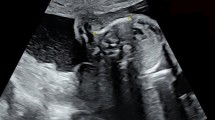Abstract
Objective
To evaluate the maternal ethnic influence and the intra and interobserver reproducibility of the nasal bone length measurement at 11–15 weeks of gestation in a Brazilian population.
Methods
A cross-sectional study with 171 normal pregnant women at 11–15 weeks was performed. Nasal bone was transabdominally measured in all cases. The patients were separated into three racial groups (White, Black and Asian) according to maternal ethnicity. The intraobserver variability was calculated through the repeated measurement of 55 fetuses by a single observer, and the interobserver variability was calculated through 44 measurements by two observers. The ANOVA test was used to compare the three racial groups. To calculate the variability, the intraobserver correlation coefficient (intra-CC), the interclass correlation coefficient (inter-CC) with 95% confidence interval, and the Bland–Altman plots were used.
Results
No statistically significant difference could be observed among the three races as for nasal bone length measurement (P = 0.934). The intraobserver variability was considered very good [intra-CC 0.92–IC 95% (0.902; 0.947)], as well as the interobserver variability [inter-CC 0.91–IC 95% (0.873; 0.940)].
Conclusions
There is no significant difference in nasal bone length measurement among the three races analyzed. Nasal bone length measurement is reproducible.



Similar content being viewed by others
References
Cuckle H, Nanchahal K, Wald N (1991) Birth prevalence of Down’s syndrome in England and Wales. Prenat Diagn 11:29–34
Down LJ (1866) Observations on an ethnic classification of idiots. Clinical lectures and reports. London Hospital 3:259–262
Farkas LG, Katic MJ, Forrest CR, Litsas L (2001) Surface anatomy of the face in Down’s syndrome: linear and angular measurements in the craniofacial regions. J Craniofac Surg 12:373–379
Cicero S, Curcio P, Papageorghiou A, Sonek J, Nicolaides K (2001) Absence of nasal bone in fetuses with trisomy 21 at 11–14 weeks of gestation: an observation study. Lancet 358:1665–1667
Orlandi F, Bilardo CM, Campogrande M, Krantz D, Hallahan T, Rossi C, Viora E (2003) Measurement of nasal bone length at 11–14 weeks of pregnancy and its potential role in Down syndrome risk assessment. Ultrasound Obstet Gynecol 22:36–39
Otano L, Aiello H, Igarzabal L, Matayoshi T, Gadow EC (2002) Association between first trimester absence of fetal nasal bone on ultrasound and Down’s syndrome. Prenat Diagn 22:930–932
Avdogou K, Papageorghiou A, Bindra R, Spencer K, Nicolaides KH (2005) Prospective first-trimester screening for trisomy 21 in 30,564 pregnancies. Am J Obstet Gynecol 192:1761–1767
Cicero S, Avdidou K, Rembouskos G, Kagan KO, Nicolaides KH (2006) Nasal bone in first-trimester screening for trisomy 21. Am J Obstet Gynecol 195:109–114
Cicero S, Sonek JD, McKenna DS, Croom CS, Johnson L, Nicolaides KH (2003) Nasal bone hypoplasia in trisomy 21 at 15–22 weeks’ gestation. Ultrasound Obstet Gynecol 21:15–18
Chen M, Lee CP, Leung KY, Hui PW, Tang MH (2004) Pilot study on the midsecond trimester examination of the nasal bone in the Chinese population. Prenat Diagn 24:87–91
Prefumo F, Sairam S, Bhide A, Penna L, Hollis B, Thilaganathan B (2004) Maternal ethnic origin and fetal nasal bones at 11–14 weeks of gestation. Br J Obstet Gynecol 111:109–112
Collado F, Bombard A, Li V, Julliard K, Aptekar L, Weiner Z (2005) Ethnic variation of fetal nasal bone length between 11–14 weeks’ gestation. Prenat Diagn 25:690–692
Bunduki V, Ruano R, Miguelez J, Yoshizaki CT, Kahhale S, Zugaib M (2003) Fetal nasal bone length: reference range and clinical application in ultrasound screening for trisomy 21. Ultrasound Obstet Gynecol 21:156–160
Senat MV, Bernard JP, Boulvain M, Ville Y (2003) Intra- and inter-operator variability in fetal nasal bone assessment at 11–14 weeks of gestation. Ultrasound Obstet Gynecol 22:138–141
Bekker MN, Twisk JW, van Vugt JM (2004) Reproducibility of the fetal nasal bone length measurement. J Ultrasound Med 23:1613–1618
Kanellopoulos V, Katsetos C, Economides DL (2003) Examination of fetal nasal bone and repeatability of measurement in early pregnancy. Ultrasound Obstet Gynecol 22:131–134
Bland JM, Altman DG (1986) Statistical methods for assessing agreement between two methods of clinical measurement. Lancet 1:307–310
Zoppi MA, Ibba RM, Axiana C, Floris M, Manca F, Monni G (2003) Absence of fetal nasal bone and aneuploidies at first-trimester nuchal translucency screening in unselected pregnancies. Prenat Diagn 23:496–500
Cicero S, Rembouskos G, Vandecruys H, Hoog M, Nicolaides KH (2004) Likelihood ratio for trisomy 21 in fetuses with absent nasal bone at the 11–14 weeks scan. Ultrasound Obstet Gynecol 23:218–223
Cicero S, Longo D, Rembouskos G, Sacchini C, Nicolaides KH (2003) Absent nasal bone at 11–14 weeks of gestation and chromosomal defects. Ultrasound Obstet Gynecol 22:31–35
Sonek JD, McKenna D, Webb, Croom C, Nicolaides KH (2003) Nasal bone length throughout gestation: normal ranges on 3,537 fetal ultrasound measurements. Ultrasound Obstet Gynecol 21:152–155
Wong SF, Choi H, Ho LC (2003) Nasal hypoplasia: is it a common finding amongst chromosomally normal fetuses of southern Chinese women? Gynecol Obstet Invest 26:99–101
Moon MH, Cho JY, Lee YM, Young HL, Yang JH, Kim MY, Park SH (2006) Nasal bone length at 11–14 weeks of pregnancy in the Korean population. Prenat Diagn 26:524–527
Chen M, Lee CP, Tang R, Chan B, Ou CQ, Tang MH (2006) First-trimester examination of fetal nasal bone in the Chinese population. Prenat Diagn 26:703–706
Author information
Authors and Affiliations
Corresponding author
Rights and permissions
About this article
Cite this article
Cossi, P.S., Bussamra, L.C.S., Araujo Júnior, E. et al. Ethnic variation and variability of fetal nasal bone length at 11–15 weeks of gestation in a Brazilian population: preliminary results. Arch Gynecol Obstet 278, 431–435 (2008). https://doi.org/10.1007/s00404-008-0606-7
Received:
Accepted:
Published:
Issue Date:
DOI: https://doi.org/10.1007/s00404-008-0606-7




